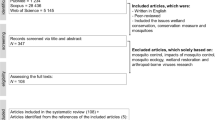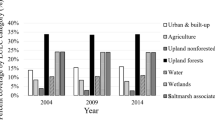Abstract
The Domaine de la Palissade is a 700-ha nature reserve located at the mouth of the Rhône river in southern France. Since 2006, the tidal wetlands have been sprayed with Bacillus thuringiensis israelensis (Bti) and water level fluctuations minimized to reduce mosquito nuisance. Aerial spraying of VectoBac® 12AS (32 ITU/ha) is carried out 10 to 23 times a year, whenever Ochlerotatus caspius and Oc. detritus larvae develop, covering between 611 and 1937 cumulated hectares. Long-term trends (2000–2013) in monthly abundance of 50 bird species were compared with two nearby nature reserves that served as controls. A significant decrease in abundance of eight species (from 1958 to 941 monthly counts) was attributed to mosquito control operations and more specifically to: (1) aircraft disturbance caused by aerial spraying in a proportion of 36%, affecting mostly ducks; (2) stabilization of water levels in a proportion of 34%, affecting mostly grebes; and/or (3) reduced food resources caused by Bti effects in a proportion of 30%, affecting mostly waders. The European coot, affected negatively by all three factors, suffered the highest decline. Alternatively, the lower water levels and higher salinity resulting from the reduced exchanges with the Rhône River had a positive impact on five species, mostly gull and shorebirds (from 201 to 280 monthly observations). Overall, this study suggests a 23% significant decrease in waterbird abundance due to mosquito control, in spite of the collaboration between site managers and the operator of mosquito control to minimize negative effects on the non-target fauna.





Similar content being viewed by others
Data availability
Data not owned by authors.
References
Allgeier S, Frombold B, Mingo V, Brühl CA (2018) European common frog Rana temporaria (Anura: Ranidae) larvae show subcellular responses under field-relevant Bacillus thuringiensis var. israelensis (Bti) exposure levels. Environ Res 162:271–279
Allgeier S, Kästel A, Brühl CA (2019) Adverse effects of mosquito control using Bacillus thuringiensis var. israelensis: Reduced chironomid abundances in mesocosm, semi-field and field studies. Ecotoxicol Environ Saf 169:786–796
Balenghien T, Carron A, Sinègre G, Bicout DJ (2010) Mosquito density forecast from flooding: population dynamics model for Aedes caspius (Pallas). Bull Entomol Res 100:247–254
Beck N, Mesleard F, Mondain-Monval JY (1999) Impact de la gestion hivernale des rizières de Camargue sur les macro-invertébrés aquatiques et sur la Bécassine des Marais (Gallinago gallinado). Gibier Faune Sauvage 6:123–141
Bregnballe T, Aaen K, Fox AD (2009) Escape distances from human pedestrians by staging waterbirds in a Danish wetland. Wildfowl 2009(2):115–130
Brühl C, Després L, Frör O, Patil CD, Poulin B, Tetreau G, Allgeier S (2020) Environmental and socioeconomic effects of mosquito control in Europe using the biocide Bacillus thuringiensis subsp. israelensis (Bti). Sci Total Environ 724:137800
Colin MH (2005) Aircraft operations near concentrations of birds in Antarctica: the development of practical guidelines. Biol Conserv 125:309–322
Cramp S, Simmons KEL (1977) The Birds of the Western Palearctic. Volume I. Oxford University Press, Oxford
Cramp S, Simmons KEL (1980) The Birds of the Western Palearctic. Volume II. Oxford University Press, Oxford
Cramp S, Simmons KEL (1983) The Birds of the Western Palearctic. Volume III. Oxford University Press, Oxford
Després L (2020) Le paradoxe des zones humides d’Europe: protégées, mais démoustiquées. Sfé2 https://www.sfecologie.org/regard/r92-sept-2020-laurence-despres-zones-humides-et-bti/ . Accessed 21 Sept 2013
Duguma D, Hall MW, Rugman-Jones P, Stouthamer R, Neufeld JD, Walton WE (2015) Microbial communities and nutrient dynamics in experimental microcosms are altered after the application of a high dose of Bti. J Appl Ecol 52:763–773
Foucart S (2019) Et le Monde devint silencieux. Seuil, Paris
Gutierrez-Villagomez JM, Patey G, To TA, Lefebvre-Raine M, Lara-Jacobo LR, Comte J, Klein B, Langlois VS (2021) Frogs respond to commercial formulations of the biopesticide Bacillus thuringiensis var. israelensis, especially their intestine microbiota. Environ Sci Technol 55:12504
Jakob C, Poulin B (2016) Indirect effects of mosquito control using Bti on dragonflies and damselflies (Odonata) in the Camargue. Insect Conserv Divers 9:161–169
Kästel A, Allgeier S, Brühl CA (2017) Decreasing Bacillus thuringiensis israelensis sensitivity of Chironomus riparius larvae with age indicates potential environmental risk for mosquito control. Sci Rep 7:13565
Kerbiriou C, Le Viol I, Robert A, Porcher E, Gourmelon E, Julliard R (2009) Tourism in protected areas can threaten wild populations: From individual response to population viability of the Chough Pyrrhocorax Pyrrhocorax. J Appl Ecol 46:657–665
Land M, Bundschuh M, Hopkins RJ, Poulin B, McKie BG (2019) What are the effects of control of mosquitoes and other nematoceran Diptera using the microbial agent Bacillus thuringiensis israelensis (Bti) on aquatic and terrestrial ecosystems? Environ Evid 8:32
Lefebvre G, Davranche A, Willm L, Campagna J, Redmond L, Merle C, Guelmami A, Poulin B (2019) Introducing WIW for detecting the presence of water in wetlands with Landsat and Sentinel satellites. Remote Sens 11(19):2210
Parrinello G, Bécot R (2019) Regional planning and the environmental impact of coastal tourism: The Mission Racine for the redevelopment of Languedoc-Roussillon’s littoral. Humanities 8:13
Perrow RM, Schutten JH, Howes JR, Holzer T, Madgwick FJ, Jowitt AJD (1997) Interactions between coot (Fulica atra) and submerged macrophytes: the role of birds in the restoration process. Dev Hydrobiol 119:241–255
Pirot J-Y, Pont D (1987) Le canard souchet (Anas Clypeata L.) hivernant en Camargue: alimentation, comportement et dispersion nocturne. Rev Ecol 42:59–79
Poulin B (2012) Indirect effects of bioinsecticides on the nontarget fauna: The Camargue experiment calls for future research. Acta Oecol 44:28–32
Poulin B, Lefebvre G, Paz L (2010) Red flag for green spray: adverse trophic effects of Bti on breeding birds. J Appl Ecol 47:884–889
Poulin B, Lefebvre G, Muranyi-Kovacs C, Hilaire S (2017) Mosquito Traps: An Innovative, Environmentally Friendly Technique to Control Mosquitoes. Int J Environ Res Public Health 14:3:313
Poulin B, Lefebvre G (2018) Perturbation and delayed recovery of the reed invertebrate assemblage in Camargue marshes sprayed with Bacillus thuringiensis israelensis. Insect Sci 25:542–548
Tétrel C, Bonnet X (2010) Bilan des suivis mis en place sur le domaine de la Palissade en parallèle des opérations de démoustication. Syndicat mixte pour la gestion du domaine de la palissade, 25 pp. http://www.parc-camargue.fr/getlibrarypublicfile.php/0565acbfe133b5a04b7d8a56840b3d43/parc-camargue/_/collection_library_fr/201100083/0001/Palissade_suivi_bti.pdf . Accessed 21 Sept 2013
Tamisier A, Grillas P (1994) A review of habitat changes in the Camargue: An assessment of the effects of the loss of biological diversity on the wintering waterfowl community. Biol Conserv 70:39–47
Theissinger K, Röder N, Allgeier S, Beermann AJ, Brühl CA, Friedrich A, Michiels S, Schwenk K (2019) Mosquito control actions affect chironomid diversity in temporary wetlands of the Upper Rhine Valley. Mol Ecol 28:4300–4316
Tilquin M, Paris M, Reynaud S, Despres L, Ravanel P, Geremia RA, Gury J (2008) Long lasting persistence of Bacillus thuringiensis Subsp. israelensis (Bti) in mosquito natural habitats. PLoS ONE 3(10):e3432
Acknowledgements
We are indebted to the Parc natural régional de Camargue for the financial and technical coordination of this project, to EID-Méditerranée for their collaboration regarding mosquito control operations, and to the managers of Tour du Valat (Damien Cohez) and Vaccarès (Société Nationale pour la Protection de la Nature) reserves for kindly providing their long-term data on bird abundance. Thanks are extended to Loïc Willm and Maud Dessein for their contribution to tables and figures, and to all the people who contributed to collect field data: Jean-Christophe Briffaud, Antoine Arnaud, Thomas Galewski, Nelly Dal Pos, Emmanuel Vialet, Xavier Bonnet, Vincent Grapin, Denis Lafage and Lydie Catala-Malkas.
Funding
This study was funded by the Parc naturel régional de Camargue.
Author information
Authors and Affiliations
Contributions
CT contributed to the study conception and design as well as data collection regarding disturbance assessment; data analyses were performed by GL; data interpretation and writing of the manuscript were performed by BP. All authors commented on previous versions of the manuscript and approved its final version.
Corresponding author
Ethics declarations
Conflict of interest
All authors certify that they have no affiliations with or involvement in any organization or entity with any financial interest or non-financial interest in the subject matter or materials discussed in this manuscript.
Additional information
Publisher’s Note
Springer Nature remains neutral with regard to jurisdictional claims in published maps and institutional affiliations.
Rights and permissions
About this article
Cite this article
Poulin, B., Tétrel, C. & Lefebvre, G. Impact of mosquito control operations on waterbirds in a Camargue nature reserve. Wetlands Ecol Manage 30, 1049–1064 (2022). https://doi.org/10.1007/s11273-021-09834-4
Received:
Accepted:
Published:
Issue Date:
DOI: https://doi.org/10.1007/s11273-021-09834-4




